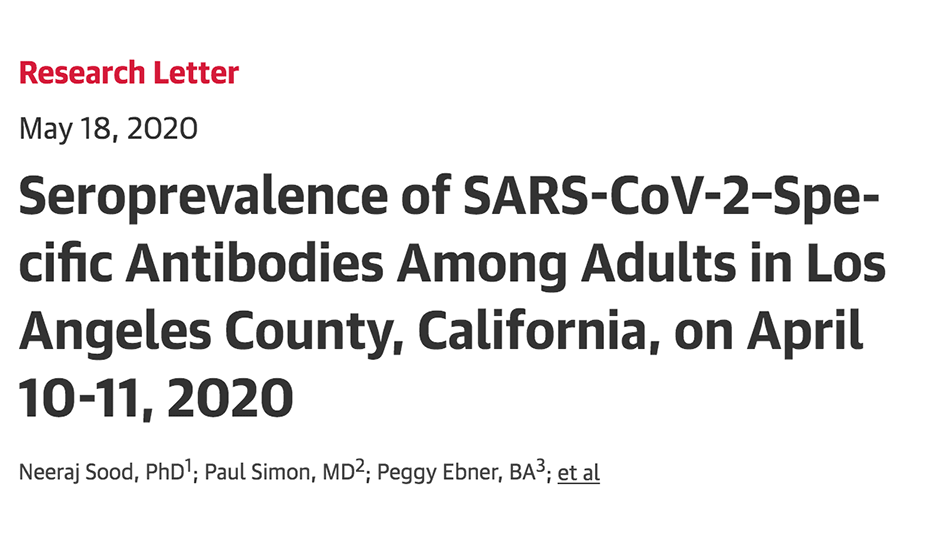Results from the first phase of a COVID-19 antibody study in Los Angeles County have been published in JAMA, the Journal of the American Medical Association, verifying preliminary results that were released last month.
Full study available at JAMA.
Citation: Sood, N., Simon, P., Ebner, P., Eichner, D., Reynolds, J., Bendavid, E., & Bhattacharya, J. Seroprevalence of SARS-CoV-2–Specific Antibodies Among Adults in Los Angeles County, California, on April 10-11, 2020. JAMA.
Most reports of confirmed COVID-19 cases are validated through a test that relies on active infections; these estimates miss individuals who have recovered from infection who did not get tested, either because they had mild or no symptoms or because of limited availability of testing. In contrast, this study seeks to estimate the percent of the population that has antibodies—a sign of past infection.
After testing a community sample of 865 residents for antibodies to the new coronavirus, researchers with USC and the Los Angeles County Department of Public Health calculated that many more individuals in L.A. County had SARS-CoV-2 antibodies than previously thought. After adjusting for test sensitivity and specificity, the weighted prevalence of SARS-CoV-2 antibodies was 4.65 percent (confidence interval: 2.52%-7.07%).
“The number of confirmed COVID-19 cases is a poor proxy for the extent of infection in the community,” explained lead investigator Neeraj Sood, professor at the USC Price School for Public Policy and senior fellow at the USC Schaeffer Center for Health Policy and Economics. “We need to update models and forecasts based on new evidence. We’re still far away from herd immunity or the end of the epidemic. We need to look at a longer time horizon when evaluating policy decisions.”
Study Sample and Methods
The researchers used a proprietary database maintained by LRW Group, a market research firm. A random sample of 1952 individuals was invited via email and phone calls, with quotas for enrollment based on age, sex, race and ethnicity. Participation was restricted to one adult per household.
Over the course of four days, the researchers tested 865 adults using a COVID-19 antibody test from Premier Biotech. Two tests were inconclusive due to faulty test kits. Of the resulting 863 participants, 60% were women, 55% were aged 35 to 54 years old, 58% were white, and 43% had yearly household incomes greater than $100,000. Several participants reported that they had experienced symptoms of COVID-19 infection in the past 12 months: 13% reported that they had a fever with cough, 9% had a fever with shortness of breath and 6% had loss of smell or taste.
Researchers analyzed the results to account for the accuracy of the tests as well as the demographics of the participants.
Study Limitations
The study has a number of limitations. One, the results may have been skewed by an overrepresentation of people who experienced COVID-like symptoms in the past, potentially driving the number of positive tests up. Second, infection rates vary by community and neighborhood, making generalizations challenging. Infection rates also vary by geography, income, race, ethnicity and neighborhood. Third, prevalence estimates could change with new information on the accuracy of test kits used.
The study is ongoing.
Contributors and Funding
Contributors to the study include co-lead Paul Simon, chief science officer at L.A. County Department of Public Health; Peggy Ebner of the Keck School of Medicine of USC; Daniel Eichner of the Sports Medicine Research & Testing Laboratory; Jeffrey Reynolds of LRW Group; and Eran Bendavid and Jay Bhattacharya of Stanford University School of Medicine.
The study was supported with funding from the USC Schwarzenegger Institute for State and Global Policy, the USC Lusk Center for Real Estate, the USC president’s office, the Jedel Family Foundation, LRW Group, Soap Box Sample, the Stanford COVID-19 Seroprevalence Studies fund and several individual donors.
